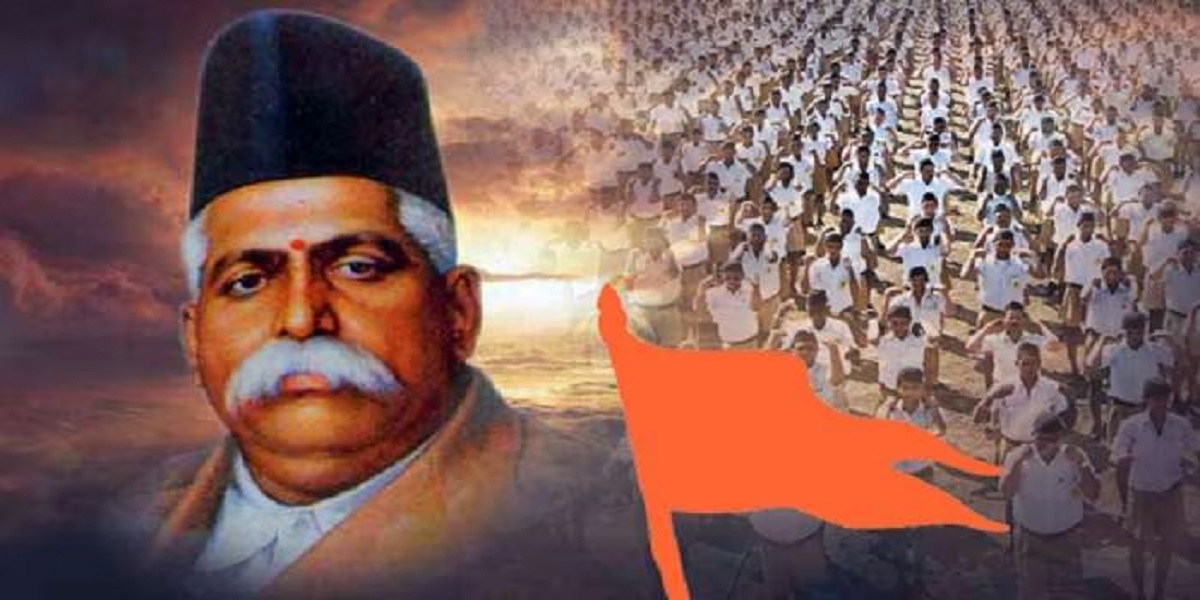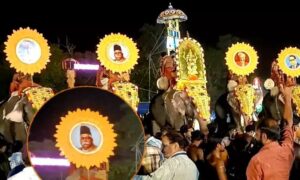There is an attempt to rebrand Hedgewar as a social reformer, positioning him alongside Ambedkar, Ayyankali, and Sree Narayana Guru.
Published Apr 25, 2025 | 9:00 AM ⚊ Updated May 24, 2025 | 7:40 PM

The story of how the Sangh Parivar subtly induced and introduced its ideological icons.
Synopsis: The RSS’s attempt to mainstream its ideologue KB Hedgewar into Kerala society has raised alarm in political circles. While the Sangh Parivar portrays him as a freedom fighter and reformer, critics strongly disagree.
“Karuna Muraleedhara…” A song that echoes softly through the memory lanes of Kerala’s 80s and 90s childhoods. To many, it was more than a bhajan, it was the serene anthem of Sunday mornings.
It marked the beginning of Balagokulam, a cultural programme crafted by the Sangh Parivar, aimed to nurture Hindu values and identity among children.
Lord Krishna stood at the centre — playful, divine, familiar. However, look closer. When this prayer was offered, Krishna was not alone. On his left and right stood two other figures, not from mythology but from history.
Keshav Baliram Hedgewar, introduced as Doctorji, and Madhav Sadashivrao Golwalkar, introduced as Guruji. To the innocent minds gathered on temple halls and friends’ houses, they were presented not as political architects, but as gurus.
This is where the story begins. The story of how the Sangh Parivar subtly induced and introduced its ideological icons. Decades later, the same Sangh Parivar, now in power at the Centre, is no longer content with a silent presence. The efforts are open, the strategies sharper.
Today, there is an attempt to rebrand Hedgewar as a social reformer, positioning him alongside BR Ambedkar, Ayyankali, and Sree Narayana Guru.
What began as a devotional offering has grown into a national narrative. And behind it all, the same prayer, the same melody, the same machine — Sangh Parivar.
Palakkad, the only municipality in Kerala governed by the BJP, has been witnessing a series of unpleasant incidents over the past week.
Of the municipality’s 52 wards, the BJP holds 28 seats, reflecting its strong presence in the region, especially through its ideological backbone, the Rashtriya Swayamsevak Sangh (RSS).
The latest flashpoint occurred on 11 April, when activists from the Youth Congress and the Democratic Youth Federation of India (DYFI) disrupted the inauguration of a proposed skill development centre for the intellectually challenged.
The centre, which is coming up on 30 cents within the municipality and is funded by a ₹1.5 crore donation from a private corporate donor, became the centre of a political storm over its proposed name, KB Hedgewar Skill Development Centre, in honour of the RSS founder.
The move sparked protests from opposition youth organisations, who accused the BJP-led municipality of attempting to advance a political ideology under the guise of a welfare initiative.
Municipal chairperson Prameeladevi defended the decision.
”There is absolutely nothing wrong in naming the centre after KB Hedgewar,” she told South First.
Opposition leaders, however, remain unconvinced. DYFI Branch Secretary Muhammed Nasim told South First that the BJP was ”trying to saffronise public spaces and institutions. We strongly object to naming the centre after Hedgewar. We won’t allow this to happen.”
District Congress Committee (DCC) Vice President Sumesh Achuthan echoed similar sentiments. ”We view this as a deliberate attempt to impose the RSS’s ideological symbols on the public. The Youth Congress will announce its next course of action at a press conference later,” he told South First.
On Sunday, 20 April, the BJP filed a police complaint against Congress MLA Rahul Mamkootathil, accusing him of inciting communal unrest with remarks about BJP leaders visiting churches during Easter. Mamkootathil said it’s better they “stay home than go with knives like in Manipur.”
The row follows his protest against naming the skill centre after Hedgewar.

During the Kollam Pooram festival at the Sree Krishnaswamy Temple in Ashramam, portraits of KB Hedgewar were displayed.
A few days after the Palakkad controversy over Hedgewar’s name, a similar incident emerged from South Kerala.
During the Kollam Pooram festival at the Sree Krishnaswamy Temple in Ashramam, portraits of Hedgewar were displayed alongside icons like Sree Narayana Guru and BR Ambedkar during the kudamattam (changing colourful parasols atop caparisoned elephants) event organised by the Puthiyakavu Temple.
The Travancore Devaswom Board (TDB) has sought a report from the assistant commissioner in Kollam, and police have registered a case under the Travancore-Cochin Hindu Religious Institutions Act, 1950.
The temple’s advisory committee claimed they were unaware of the planned display, calling it an unprecedented issue in the festival’s 30-year history.
This is the third such politically charged episode at a temple festival in the past two months. Earlier, revolutionary songs at Kadakkal Devi Temple and an alleged RSS ‘Ganageetham‘ at Kottukkal’s Manjippuzha Temple stirred similar controversies.
Following protests by the Youth Congress, which accused the CPI(M) and BJP of politicising temples, the Kollam East police filed a case.
Leader of Opposition in Kerala Assembly VD Satheesan also criticised the use of religious spaces for political messaging, reaffirming the UDF’s stance against temple politicisation.
Congress’s current opposition to naming a skill development centre in Palakkad after Hedgewar has drawn criticism over its own past.
Pranav Thamarakkulam, Yuva Morcha President from Kollam, told South First that Congress had supported a similar move in the early 1990s.
”Back in 1992-93, Congress, along with the Indian Union Muslim League, helped the BJP pass a resolution in the Thiruvananthapuram Municipal Corporation to name a road near the Sree Padmanabhaswamy Temple after Hedgewar, despite CPI(M) opposition,” he said.
The decision was made during a politically turbulent period (1988–1993), marked by frequent defections and shifting alliances within the 50-member council.
BJP councillor MS Kumar, known for his tactical moves, was instrumental in pushing the resolution through in the final year of the council’s term.
Activist and editor of Patabhedam magazine Mridula Devi S said: “It’s outrageous to equate Hedgewar with social reformers like Sree Narayana Guru, Ayyankali, Pandit KP Karuppan, and Dr Palpu, all of whom fought against caste and stood for democracy.”
“Hedgewar upheld the Manusmriti, while Ambedkar challenged and publicly ignited it. Now, Hedgewar is being subtly introduced in Kerala, through ideology, posters, protests, and perhaps, shortly, our academic curriculum.”
“This is a conscious and well-funded effort by the extreme right wing to normalise a casteist worldview. Hedgewar worked to preserve caste hierarchies, and every believer in democracy must resist this narrative. Let’s not forget, it was the RSS that killed Gandhi. Now, we are witnessing them being rebranded as social reformers in a secular state,” she told South First.
Maithreyan, an activist from Kochi, told South First, “We are debating Hedgewar’s posters in a country where our prime minister honoured Savarkar in the Central Hall of Parliament. Except for Karnataka, most southern states have a history of rejecting such so-called reformers. If we are willing to accept Mannath Padmanabhan as a social reformer, how do we then justify our protest against others?”
“Resistance is essential, but the manner in which we resist is equally important. It should not end up giving the Sangh Parivar more visibility, as is unfortunately happening in Kerala right now,” he added.
Aadi, a writer from Kerala, told South First, ”We are living in a time when the Sangh Parivar is attempting to craft new narratives and repackage old leaders from the past in a new form. They are gradually feeding the public a manipulated version of history. The right wing has always tailored historical accounts to suit their own convenience.”
However, the RSS has a different stance regarding Hedgewar.
C Ravi, an RSS worker from Kottayam, told South First that Hedgewar founded the RSS to unite Hindus against centuries of invasions and exploitation that weakened Bharat socially and economically.
“Like deer that prepare protein for predators, Hindus toiled for wealth and knowledge, only to be targeted repeatedly,” Ravi said.
He compared historical invasions, from Iran to present-day Kashmir and Kerala, to a cycle of predators attacking a peaceful people.
“Hedgewar believed unity was essential to preserve India’s cultural and spiritual heritage. His vision wasn’t anti-religion but pro-national character, urging people to rise above caste, reclaim pride in Vedic knowledge, and remember leaders like Shivaji, Maharana Pratap, and Vivekananda,” he said.
”Doctorji‘s contributions make him worthy of being listed among India’s great social reformers,” Ravi added.
According to Kerala Students’ Union (KSU) Kannur District President Athul MC, political murders, particularly involving the CPI(M) and RSS, were once a grim reality in the region. While such violence has declined in recent years, he noted that deep ideological differences still persist.
“In villages where the RSS has a strong presence, it’s common to see figures like Savarkar and Hedgewar featured on posters for cultural programmes,” he told South First.
“We must resist this trend. How can leaders of the Hindutva movement be integrated into Kerala’s progressive social fabric?” he questioned.
The Sangh Parivar’s efforts to embed itself within the broader fabric of Kerala society go beyond the popularisation of its ideologues, such as Hedgewar and VD Savarkar.
In a state like Kerala, where the Sangh has little historical presence or prominent figures, there appears to be an attempt to reinterpret historical events to align with its narrative.
This is evident in their efforts to popularise Chettur Sankaran Nair, the only Malayali to have served as Congress president.
Recently, Prime Minister Narendra Modi praised Nair’s bold stand against the British following the Jallianwala Bagh massacre, during a foundation event in Haryana.
Ahead of Nair’s death anniversary on 24 April, Union Minister of State and Thrissur MP Suresh Gopi visited his family members in Palakkad and Ottapalam, and hinted at plans for a memorial.
Though a visit to Nair’s memorial in Mankara was called off due to poor road access, Gopi spent time with Nair’s descendants and viewed family archives. Despite Nair’s national legacy, tributes have so far been limited to local ceremonies.
The recent release of the film Kesari 2, based on his life, and BJP’s outreach suggest a shift towards honouring his contributions more prominently.
(Edited by Muhammed Fazil.)
